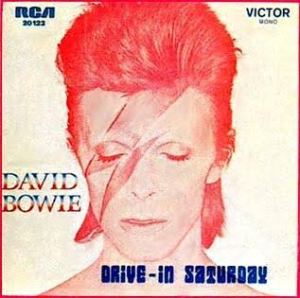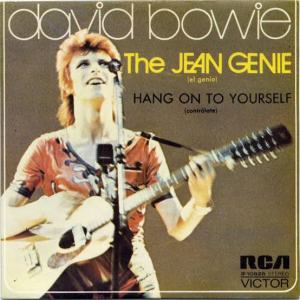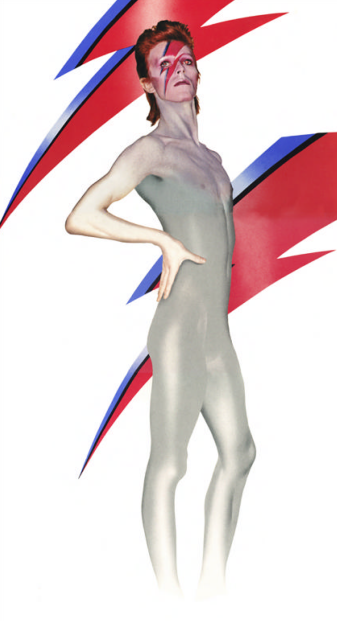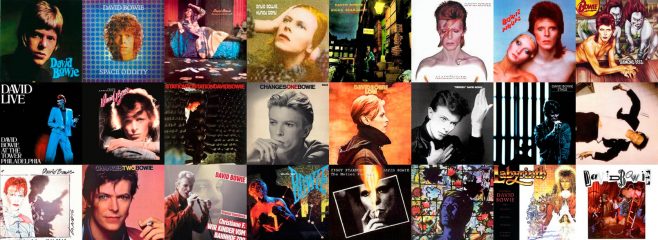
“Aladdin Sane” is David Bowie’s 6th studio album, originally released on 13th April 1973.
At the start of January 1973, Bowie was facing a scenario for the first time ever in his career, having to complete an album from a position of fame. After the success of his break-through album “The Rise and Fall of Ziggy Stardust and the Spiders from Mars“, Bowie had made the big time, with ever increasing crowd sizes and enthusiasm at his sold out concerts. With a short gap in his frantic live schedule, Bowie had a week in mid January in which to complete his follow-up album and try to replicate the success and acclaim he had with Ziggy Stardust. So no pressure then…
With his ever faithful Spiders From Mars (Mick Ronson on guitar, Trevor Bolder on bass and Mick Woodmansey on drums) and with Ken Scott again as producer, the main new musical ingredient here was Mike Garson on piano, who’s jazz styled tinkering would add a magical touch to many of the tracks. With Ken Fordham and Brian Wilshaw also from the touring band playing saxophone, the studio band was complete.
With most of the songs already written on the road whist touring in the US (and indeed with “The Jean Genie” already in the can and released as a single in November 1972), Bowie at the time described “Aladdin Sane” as Ziggy Stardust in America. Although often considered another concept album, it really isn’t, with the songs simply a collection of glam rock classics that have no real connection. The Aladdin Sane character is simply just David Bowie playing Ziggy Stardust playing Aladdin Sane.
With so little time available in which to record the album, Bowie was under tremendous pressure to record an album of similar quality and success to Ziggy Stardust. And in the main, Bowie succeeded, creating an album that will always be regarded as one of the all-time glam rock classics and indeed an all-time rock classic.
The album opens with the frantic “Watch That Man“, which is perhaps the weakest track on the album and a sign of how the album was somewhat rushed during the recording process. With a bluesy sound not unlike the current Rolling Stones (in fact exactly like the Rolling Stones), Bowie’s vocals are lost within the mix and suffers as a result. Telling the sordid tale of a crazy rock ‘n’ roll party, the band really cranks things up, but I’ve always thought this track works best live than here on record. An arguably superior version was recording by Lulu with David Bowie and the Spiders as the B-Side to her “The Man Who Sold The World” single and is well worth a listen.
Things slow down with the title track, “Aladdin Sane”(1913-1938-197?)“, written on the ship RMHS Ellinis on his way back from the US to the UK the title suggesting a new world war is not far away. With a somewhat sad, dreamy vocal delivery, the track comes alive during Mike Garson’s extraordinary, frantic, avant-garde improvised piano solo. I’ve heard this track 100s of times and I’ve yet to tire of the rush of listening to Mike’s piano solo, I just love it (although many I’m sure would hate it). The title is a play on “A lad insane”, no doubt inspired by his mentally unstable half-brother Terry. That someone who is just getting used to fame would record such an amazingly un-commercial track is a clear sign of Bowie’s musical adventurism to come.
“Drive-In Saturday” comes next and was the second single from the album, peaking at No 3. on the UK charts. With very a 50’s vibe that was Bowie’s influential introduction to rock, the song paradoxically is about a future post-apocalyptic society where the art of making love is forgotten and needs to be re-learnt via old porn films. So typical Bowie story telling then. Written on a train between Seattle and Phoenix, it was inspired when Bowie saw strange lights and domes in the barren landscapes. With its beautifully surreal verses and catchy do-wop arrangements and chorus, this is a real gem in the Bowie arsenal and possibly one of his lesser known “hits”. Sadly, no official video was made for the single although his wonderful appearance on the Russell Harty show serves as the unofficial video. Watch it here.

“Panic In Detroit” is a real glam rocker, written obviously in Detroit and clearly inspired by Iggy Pop and the chaotic environment that created such a rock ‘n’ roll animal. Musically, it’s everywhere, with Ronson’s heavy guitar sound and Woody’s Latin style congas drums fighting to take dominance. An excellent live version from the 1974 Diamond Dogs US tour featured on the B-side of the “Knock on Wood” single. Add this to the essential glam-rock classics list.
“Cracked Actor” closes side one of the album and is another superb, hard rocking glam track. Written in LA, it tells the sordid tale of an ex-Hollywood great sadly reminiscing of days gone by. With Ronson and the Spiders again in inspired form, this is a fabulous rocker which was one of Bowie’s live favourites, featuring in many of his tours. Both in the 1974 Diamond Dogs and 1983 Serious Moonlight tours, Bowie performed this song as a theatrical piece with Shakespearean cape and skull in hand. OK, add this also to the essential glam-rock classics list.
Side two starts with the somewhat confusing “Time“. Written in New Orleans, musically, it’s another grandiose, theatrical piece, with a wonderful arrangement that features heavily Mike Garson’s piano. However lyrically, it comes across as a little half-finished and gives the sense that things were indeed rushed in getting everything down on tape in time. Detailing the pits and perils of time fast escaping through our fingers, Bowie’s vocals begin quiet and brooding before bellowing out at his histrionic best. The couplet “Time, he flexes like a whore, Falls wanking to the floor” had many teenagers giggling naughtily and parents raging in disgust which is precisely what rock ‘n’ roll is supposed to do.
Bowie goes searching in his past catalog to re-record “The Prettiest Star“, the flop single he released in 1970 that featured his friend Marc Bolan on lead guitar. Ronson does Bolan the honour of playing the guitar part almost note for note the same while Bowie does the piece justice with a beautiful, touching vocal performance. Yet another Bowie gem hidden away on this album.
I’m not much of a Rolling Stones fan, but I admit it’s hard to out rock the Rolling Stones. Yet this is precisely what Bowie does here with “Let’s Spend The Night Together” with an energetic performance of the Stones classic (which I also thought was always a little limp for a Stones track). Here Bowie and the Spiders really vamp it up, with the section where Bowie says “Do it. Let’s make love” outrageously sublime. To prove this wasn’t fluke, he would perform this throughout the upcoming Aladdin Sane tour with similar success.
“The Jean Genie” is the best known of all the tracks here and is a true Bowie classic, reaching No.2 in the UK singles charts when released the previous November. Written in Detroit and New York, the title is based on influential french author Jean Genet. With its Bo Diddley R&B like riff and sleazy Iggy Pop inspired lyrics, over-familiarity can easily make one forget just what a brilliant song (and performance) this is. It’s a song that Bowie would play live very frequently throughout his career. The wonderful Mick Rock video featuring Andy Warhol’s Cyrinda Foxe at the Mars Hotels only helped the single success. Watch the video here.

The album closes with the killer “Lady Grinning Soul” which was written in London. This is my favourite track off the album and one of my all-time Bowie favourites. With Ronson’s wonderful acoustic and electric guitar parts and Garson’s marvellous piano, musically it’s just a stunningly beautiful ballad. Add then one of Bowie’s finest vocal performances and you have the makings of a true masterpiece. Inspired by his meeting with Claudia Lennear, this just oozes tenderness and romance. I’m not aware of this track having ever been performed live by Bowie, which is both a shame and perfectly understandable as it’s hard to imagine how to beat this performance. A simply gorgeous way to end the album.
The album was both an artistic and commercial triumph. Based on massive pre-sales alone, the album reached No. 1 on the UK charts, becoming Bowie’s first No. 1 success. It would help to further propel Bowie as the “next big thing”, especially in the UK but also in the important US market where the album reached a respectable No. 17. The album’s success would help give Bowie confidence (after so many years of failures and false starts) to later explore so many other musical territories.
Bowie would tour the album on the hugely successful “Aladdin Sane” tour which included the US, Japan and finally up and down the breadth of the UK, performing most tracks except never Lady Grinning Soul. On the 3rd July 1973, only a few months after the album’s release, Bowie would kill Ziggy Stardust on stage by famously stating he would never tour again. Although of course he would (within a year), things were never quite the same again.
The album marks a couple of notable departures. Firstly, this would be the last studio album to feature the brilliant and criminally under-rated Mick “Woody” Woodmansey on drums, who starred on Bowie’s 3 previous albums (and none of which have yet been discussed on my countdown list). After Bowie’s “retirement” on 3 July, he would not perform with Bowie again.
The album also marks the last album to be recorded at London’s Trident Studio’s where he had previously recorded much of his previous material.
Over the years, there have been a number of notable re-releases. In 1990, the album was re-released as part of the fabulous Rykodisc CD series although sadly, “Aladdin Sane” was the only album in the series to not feature any bonus tracks. A sign perhaps there was precious little left over after the recording sessions.
In 2003, the 30th Anniversary Edition version was released, with an additional CD featuring mainly single edits and live versions. However, two tracks are worth mentioning:
“John, I’m Only Dancing“, the follow-up single to Bowie’s (second) break-through single “Starman” was re-recorded during the Aladdin Sane sessions. Said to depict an argument within a gay relationship, this version known as the “sax version”, has a sax based arrangement (obviously) and a slightly livelier vibe to the original. It’s a great song but a somewhat risky choice so early in Bowie’s rise to stardom and indeed deemed too risque for the conservative US market. The Mick Rock video is one of Bowie’s best. Watch it here.
“All The Young Dudes” was given by Bowie to “Mott The Hoople” who with Bowie’s help also as producer made it into a monster hit and resurrected the failing stocks of the band. Bowie recorded his own version of the classic track during the Aladdin Sane sessions and although it doesn’t contain the same energy and spark of the original, is charming and worth checking out nonetheless.
In 2013, a newly remaster version in celebration of the 40th Anniversary was released with packaging similar to the original album release.
The album cover features arguably Bowie’s most iconic image, the lightening bolt Aladdin Sane photo taken by Brian Duffy. I have never quite worked out though what the paint-brushed liquid balanced in Bowie’s collarbone is meant to represent? RCA splashed out with the original album packaging by featuring an open gate-fold image of the thin Aladdin Sane slowly fading into a shadowy, somewhat spooky, sexless gray form below the chest.

The album is a masterpiece from the Glam-Rock, early to mid 70’s period, but its futuristic feel gives it a legitimacy and modernness that still lasts into the 2020s. Bowie had a big test to pass, that being can he show the success that was the Ziggy Stardust phenomenon be replicated and truly put him on-board the starship to stardom. Bowie passed the test spectacularly with “Aladdin Sane”. But Bowie knew if was to expand and grow creatively, he had to eventually move on from his glam rock God status. He had one more glam rock masterpiece left in him before he made the decision to indeed move on creatively, but that’s a story for another day.
Best Tracks: “Cracked Actor“, “The Jean Genie“, “Lady Grinning Soul“
